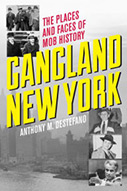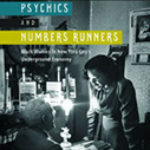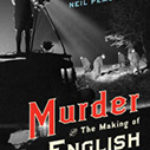Gangland New York: The Places and Faces of Mob History

Author: Anthony M. DeStefano
Publisher: Lanham, MD: Rowman & Littlefield, 2015. 202p.
Reviewer: Jay Albanese | September 2015
If you’re headed to New York City, and wonder precisely where and when major events (mostly murders) actually occurred during the history of organized crime in New York, this is your book. With three maps, 100 black-and-white photos, and an appendix of 74 short bios of crime figures discussed in the book, it serves as an historical travel guide and locator to New York’s rich history of organized crime.
The book’s focus is the geography of organized crime in New York. This is illustrated by the fact that addresses are bold-faced throughout, whereas names of individuals are not. Locations of key events are also noted on the maps included.
The book begins by talking about lesser-known gangs from the 19th century in the early chapters and, like most chronicles of organized crime, picks up steam from Prohibition to the present. One fact that becomes quite clear is that organized crime groups historically have focused primarily on local extortion and gambling rackets, and without the Prohibition Era, one wonders if organized crime ever would have become as large and successful as it did during the 20th century.
The narrative proceeds chronologically until the last seven of the book’s 20 chapters, which highlight specific geographic areas and individuals. As a historical account, it is written without footnotes; nor is it heavily sourced. Indeed, there are many histories of New York area organized crime which contain much greater detail, but this is not the author’s purpose. Instead, no more than a few pages are devoted to any individual or event, so it moves along breezily, although some of the lore of organized crime does not always align with the facts. For example, informer Joe Valachi’s version of the Castellamarese War used in the book has not been supported by subsequent investigations by historians. But the sites of many infamous murders, attempts, and arrests are well documented, so a visitor to New York has a precise guide to where and when specific events occurred, including some of the most infamous mob hits, such as those of Salvatore Maranzano, Albert Anastasia, Joey Gallo, Joseph Colombo, Carmine Galante, and Paul Castellano. It still amazes how few of these murders were ever solved, although prosecution success grew dramatically from the 1980s forward, using wiretaps, insiders-turned-informants, undercover agents, and the federal racketeering law with its long sentences—all of which helped to break down loyalty within organized crime groups.
The book devotes a great deal of space to mafia-related organized crime, because much of it occurred in New York. But it also provides brief descriptions of major organized crime-related events in Chinatown, Harlem, Hell’s Kitchen, Brooklyn, the Bronx—–covering the Jewish, Irish, and Black crime groups, and newer immigrant groups as well as the Italians. Every reader will discover some piece of information about an individual or group involved in organized crime in New York that you did not know before.
As a paperback selling for under $20, this book serves as a very useful reference and guidebook for anyone interested in the specific dates, places, and rationale for major mob events in New York City history. It also includes many of the interesting houses, restaurants, and cemeteries associated with important mob figures and events with some old photos, and some current photos, of what these sites looked like, and how they look now. The author says it best, "Gangland New York serves as an evocative guide for those who wish to tour the neighborhoods of this historic gallery of rogues."
Jay S. Albanese,
Professor,
Virginia Commonwealth University,
Wilder School of Government & Public Affairs


